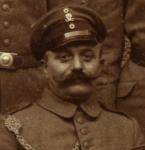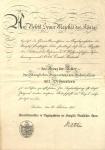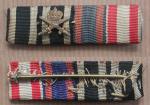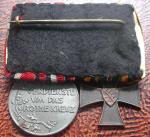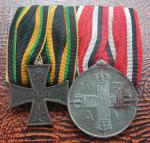-
Posts
949 -
Joined
-
Last visited
Content Type
Profiles
Forums
Blogs
Gallery
Events
Store
Everything posted by David Gregory
-

Regimental Names
David Gregory replied to Craig's topic in Great Britain: Research, Documentation & History
Paras simply refer to the rest of the army as "crap hats". -
Darrell, Thanks for that information. I think I saw one of the Pautot marked medals offered on French eBay, but I neglected to add it to my watch list. The price was around EUR 90 before the auction ended. I pick up Victory medals when the opportunity arises, but I sense myself moving down the slippery slope towards trying to find more. The British, French, Belgian and Italian ones are not difficult to find, but the rest seem to be more elusive. Representative examples from all (or being realistic most) of the nations would be a nice counterpoint to the Imperial awards of the various German states which seem to have crept up on me in recent years. Cheers, David
-
Geoff, Although I have nothing to back it up, a German collector suggested to me that the DRGM (patented) catch indicated that the badge was made after 1918. Given that the badge was only instituted in mid-1918, I wouldn't be surpised if very many of the actual badges were issued well after the end of hostilities. It is not unusual to see wound badge award documents dated in the 1930s. Does the Hammelmann book on wound badges indicate when these types were made? Cheers, David
-
Although I never set out to "get the set", I'm missing the 1914-15 and 1914-1917 crosses. Collecting side lines can become annoying, but I guess that's just one of the things collectors just have to learn to accept. Can anyone show any more award documents, preferably groups?
-
Good thread Darrel. The link you show is interesting, but from my grasp of French I understand that there were different typres of suspension arrangement and minor design details depending on the manufacturer of the pre-1950s type. Does anyone have any more information on the various types and how to date them? Specifically, what are the features to identify the type(s) issued for 1914-1918 service or earlier? Many thanks in advance, David
-
After the comments above, I had to take a closer look at my example to check the "fondling" aspect. Normally, my wife ignores me when I am in "gawking at medals" mode, but this time she asked me what was so interesting. Never mind. This certainly seems to be the most common type of French Victory Medal, but I think I saw one by a different designer recently, i.e. not Morlon. The name, if I recall correctly, began with a P. Can anyone shed any light on this or other types? Thanks in advance, David
-
If B.B. & Co. was a Turkish company and expected to export any of its products, it would make sense to use Latin alphabet characters for customers outside the Arab-speaking world, rather than something many people would not even recognise as writing, let alone a name.
-

Heer Tradition badge: Braunschweiger skull
David Gregory replied to Jacques's topic in Wehrmacht Medals, Decorations & Awards
-

Heer Tradition badge: Braunschweiger skull
David Gregory replied to Jacques's topic in Wehrmacht Medals, Decorations & Awards
Here is a group photo of a Korporalschaft at the recruit depot of Infanterie-Regiment 92 early in WW1. -
As someone who tends to use a PDA a lot, especially for entering all sorts of text while on the train, I can appreciate what a lot of work that must have been. Whenever I read any personal accounts of the fighting at Verdun, I am always strongly reminded of our walks around the battlefield. The piece above conjours up haunting memories of the cratered woods, grassy ditches around the forts and the darka and damp passages beneath them. It certainly puts all those coveted shiny objects into perspective.
-
You have a very nice award and document, Ralph. I have never seen an official award document . Yours is the first informal one I have seen. The document indicates the award was given to a member of 8. Kompagnie, Infanterie-Regiment 96. The regiment was part of 38. Infanterie-Division fighting on the Eastern front at the time of the award. IR 96 was from Reuss and, together with the iron cross, the medal was pretty much the standard award to men who served with the regiment or were citizens of the principality of Reuss. If are looking for one, good luck with the Waldeck equivalent. They are, as Rick indicated, not easy to find. /David
-
Chris, His rank was gunner and he had joined the army as an ungedienter Landsturmmann, meaning he had been assigned to the Landsturm, but had not actually served. The (F) stands for "fahrende Batterie", as opposed to "reitende Batterie". The "fahrende" designation is far more common, with men travelling on limbers or wagons or marching with the unit. "Reitende Batterien" had fewer guns, if I recall correctly, and were originally attached to mobile units such as cavalry. The gunners were all mounted and the unit was considered to be able to travel and relocate more quickly than the (F) types. Cron has some details on pages 144 and 145. Cheers, David
-
Can anyone show an example of a Hohenzollern HHOX being worn in the button hole together with a normal EK2 et al medal bar, minus the HHOX of course? I recently saw an image like this on German eBay, but cannot for the life of me imagine why I didn't buy it or at least add it to my watch list. Would this be a fashion statement, an officialy recognised wear variant, emphasis of the HHOX or just a "look what I just got" statement? Thanks in advance, David
-
According to Hessenthal & Schreiber the 1914/1918 Kriegserinnerungskreuz of Sachsen-Coburg-Gotha was a commemorative award, but it does not specify whether it was for combatants or non-combatants only. As I mentioned in the thread showing the award, I have only seen it mounted with a red cross award, so I assume it was given to non-combatants, particularly in view of the fact that Sachsen-Coburg-Gotha had other bravery and merit awards for military personnel. Whoever has the Nimmergut 4-volume series or a book dedicated to awards of this duchy ought to be able to shed more light on the matter.
-
And cetra2003 is either a previous victim unloading some his nasty fakes or it is another one of his pseudonyms: http://cgi.ebay.de/ws/eBayISAPI.dll?ViewIt...AMEWA%3AIT&rd=1 http://cgi.ebay.de/ws/eBayISAPI.dll?ViewIt...ssPageName=WDVW http://cgi.ebay.de/ws/eBayISAPI.dll?ViewIt...ssPageName=WDVW http://cgi.ebay.de/ws/eBayISAPI.dll?ViewIt...ssPageName=WDVW
-
The thread on Hohenzollern bars has prompted me to post a document for the HHOX. This is the award document to Leutnant der Reserve Ernst Paczoch of 8. Westpreussisches Infanterie-Regiment No. 175 for the Kreuz der Ritter des K?niglichen Hausordens von Hohenzollern mit Schwertern dated 26 February 1917. According to informed sources, his HHOX was gazetted in the MWB issue of 22 March 1917. Since the document is too large to fit on my scanner, the roll number 5140 doesn't appear in the scan. Unfortunately, this is the only a single document and I had no other information from the seller. I.R. 175 was part of 36. Infanterie-Division and was involved in fighting in the Chaulnes area on or near the Somme against the French more or less continuously from late June 1916 until it withdrew to the Siegfriedstellung shortly after his HHOX was awarded. I assume that he was awarded the HHOX for his involvement in the fighting on the Somme. Rick (the GOOD one) confirms that Paczoch was commissioned Lt dR 1912/13 in the same regiment. He also believes that for such an early HHOX award, to that junior an infantry officer, he must have had a death-wish. Deutschlands Heere bis 1918 by Voigt suggests that there is no regimental history and only mentions 13 winners of the Goldenes Milit?r-Verdienst-Kreuz in the regimental awards overview. It also only mentions active officers killed, as listed in the Ehrenrangliste. Rick and Glenn J confirm that the Leutnant d.R. Paczoch listed in the Ehrenmal was killed on the 18th of October 1916 as a member of R.I.R. 207. His parent prewar regiment is given as I.R. 64 though he certainly was not commissioned in May 1914. As a Leutnant d.R. Paczoch is listed for I.R. 175 it would therefore seem that "my" Paczoch survived the war. I have never seen another document to a member of I.R. 175, except for a Milit?rpass to a man that served with the regiment before the war. Does any one have any information or possible leads on Paczoch, I.R. 175 or any of the other units in the division, e.g. Infanterie-Regiment 128, Grenadier-Regiment 5, Feld-Artillerie-Regiment 36, Feld-Artillerie-Regiment 72, Pionier-Bataillon 17? Any help would be greatly appreciated. Failing that, please show your HHOX documents and tell us the story of their recipients. David
-
This bar is made of 26 mm wide ribbons and nothing glows more than it should. It looks a bit homemade to me, and an informed source on another forum was not too keen on it. But since it only cost beer money, I am not too bothered about its integrity. Does the device look OK? Many thanks for your comments and opinions. /David
-
The first bar shown below came from Detlev Niemann some time ago. Unfortunately, I didn't realise it was one of a split pair when I bought it. The "one that got away" also had a Frontk?mpfer ribbon and a blue service award ribbon, if I remember correctly. The ribbons are 16 mm wide. It could be an army or navy bar, and I am sure Rick (the GOOD one) more or less identified one with a blue backing some time ago. Minty bars are nice, but these salty ones have really "been there". I wish I only knew where.


